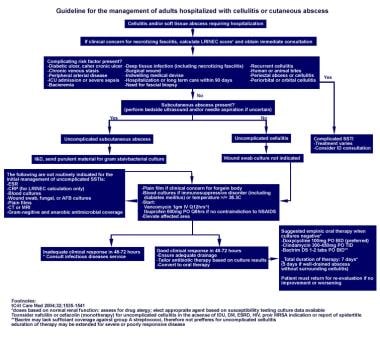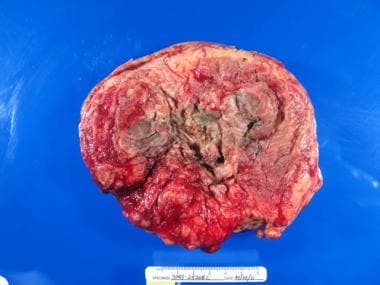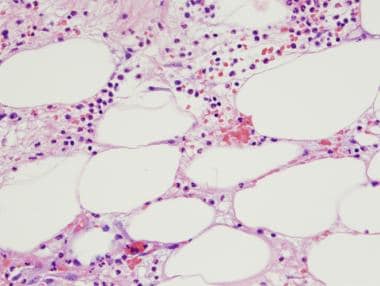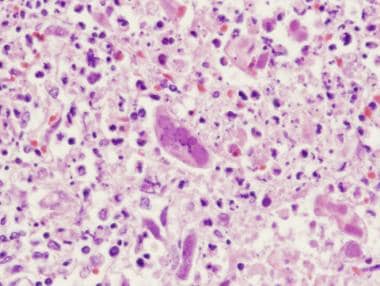Approach Considerations
Generally, no workup is required in uncomplicated cases of cellulitis that meet the following criteria [1] :
-
Limited area of involvement
-
Minimal pain
-
No systemic signs of illness (eg, fever, chills, dehydration, altered mental status, tachypnea, tachycardia, hypotension)
-
No risk factors for serious illness (eg, extremes of age, general debility, immunocompromised status)
Because the bacterial etiology of cellulitis in typical cases is expected to represent streptococcal and, less commonly, staphylococcal infection, additional procedures are also usually unnecessary. However, in more severe disease or unique clinical scenarios, additional procedures may be indicated. [1]
For serious infections, perform a blood culture, Gram stain, and culture of needle aspiration or punch biopsy specimens to pinpoint the etiology. [4] Blood cultures are only positive in 5%-15% of patients with cellulitis. Aspiration of the leading edge of cellulitis margins rarely yields positive results but may be performed if clinicians are facing difficult situations.
The IDSA recommends bloodwork for patients with skin or soft tissue infection (SSTI) who have signs and symptoms of systemic toxicity; such tests include blood cultures, complete blood cell (CBC) with differential, and levels of creatinine, bicarbonate, creatine phosphokinase, and C-reactive protein (CRP). [4]
Considerations for hospitalization
The IDSA also recommends considering inpatient admission in the presence of hypotension and/or the following laboratory findings: an elevated creatinine level; an elevated creatine phosphokinase level (2-3 times the upper limit of normal [ULN]); a CRP level >13 mg/L (123.8 mmol/L); a low serum bicarbonate level; or a marked left shift on the CBC with differential. [4]
If a complicated or deep infection is suspected, imaging studies and/or surgical consultations should be done promptly. [4]
Jenkins et al also developed guidelines for the management of patients who require hospitalization for cellulitis or cutaneous abscess. The guidelines were shown to decrease the use of resources without an adverse effect on clinical outcomes. [69]
 Guidelines for the management of patients who require hospitalization for cellulitis or cutaneous abscess. AFB = acid-fast bacilli; BID = twice daily; CRP = C reactive protein; CT = computed tomography scanning; DS = double strength; DM = diabetes mellitus; ESR = erythrocyte sedimentation rate; ESRD = end-stage renal disease; HIV = human immunodeficiency virus; ICU = intensive care unit; I&D = incision and drainage; ID = infectious disease; IDU = injection drug user; IV = intravenous; LRINEC = Laboratory Risk Indicator for Necrotizing Fasciitis; MRI = magnetic resonance imaging; MSRA = methicillin-resistant Staphylococcus aureus; NSAIDS = nonsteroidal anti-inflammatory drugs; PO = by mouth; SSTI = skin and soft-tissue infections; TID = 3 times daily. Adapted from Jenkins TC, Knepper BC, Sabel AL, et al. Decreased antibiotic utilization after implementation of a guideline for inpatient cellulitis and cutaneous abscess. Arch Intern Med. 2011;171(12):1072-9.
Guidelines for the management of patients who require hospitalization for cellulitis or cutaneous abscess. AFB = acid-fast bacilli; BID = twice daily; CRP = C reactive protein; CT = computed tomography scanning; DS = double strength; DM = diabetes mellitus; ESR = erythrocyte sedimentation rate; ESRD = end-stage renal disease; HIV = human immunodeficiency virus; ICU = intensive care unit; I&D = incision and drainage; ID = infectious disease; IDU = injection drug user; IV = intravenous; LRINEC = Laboratory Risk Indicator for Necrotizing Fasciitis; MRI = magnetic resonance imaging; MSRA = methicillin-resistant Staphylococcus aureus; NSAIDS = nonsteroidal anti-inflammatory drugs; PO = by mouth; SSTI = skin and soft-tissue infections; TID = 3 times daily. Adapted from Jenkins TC, Knepper BC, Sabel AL, et al. Decreased antibiotic utilization after implementation of a guideline for inpatient cellulitis and cutaneous abscess. Arch Intern Med. 2011;171(12):1072-9.
Moderate to Severe Cases and Systemic Symptoms
The following laboratory tests may be considered in patients who present with moderate to severe cellulitis and/or systemic symptoms [1] :
A complete blood cell (CBC) count often shows leukocytosis in the setting of severe disease; leukopenia may also be present in severe disease, especially in cases of toxin-mediated cellulitis.
The erythrocyte sedimentation rate (ESR) and C-reactive protein (CRP) level are also frequently elevated, especially in patients with severe disease requiring prolonged hospitalization. [65]
In most cases of cellulitis, blood cultures are neither necessary nor cost-effective, [12, 70] but they should be performed in patients with moderate to severe disease, [4] such as patients with cellulitis complicating lymphedema, [6] because the prevalence of bacteremia is higher in these individuals. Blood cultures are also recommended for cellulitis of specific anatomic sites, such as facial and especially ocular areas; in patients with a history of contact with potentially contaminated water; in patients with malignancy on chemotherapy, neutropenia, or severe cell-mediated immunodeficiency; and in patients with animal bites.
Gram stain, whether obtained via biopsy or aspiration of the infected area, has a low yield and is unnecessary in most cases, unless purulent material is draining or bullae or abscess is present.
If recurrent episodes of cellulitis are suspected to be secondary to tinea pedis or onychomycosis, mycologic investigations are advisable.
Creatinine levels may be helpful to assess baseline renal function in order to correctly prescribe antimicrobial agents.
Ultrasonography, CT Scanning, and MRI
Current data suggest that ultrasonography may play a role in the detection of occult abscess and direction of care, especially in an emergency department setting. [8] Ultrasonographic-guided aspiration of pus has been shown to shorten hospital stay and fever duration in children with cellulitis. [9]
If necrotizing fasciitis is a concern, computed tomographic (CT) imaging is typically used to help rule out this condition in stable patients; magnetic resonance imaging (MRI) can be performed, [10] but MRI typically takes much longer than CT scanning. However, strong clinical suspicion of necrotizing fasciitis should prompt surgical consultation without delay for imaging. [1]
Aspiration, Dissection, and Biopsy
Needle aspiration should be performed only in selected patients and/or in unusual cases, such as in cases of cellulitis with bullae or in patients who have diabetes, are immunocompromised, are neutropenic, are not responding to empiric therapy, or have a history of animal bites or immersion injury. [1, 11, 12, 13]
Aspiration or punch biopsy of the inflamed area may have a culture yield of 2-40% and is of limited clinical value in most cases. [14] By contrast, Gram stain and culture following incision and drainage of an abscess yields positive results in more than 90% of cases. [4]
Dissection of the underlying fascia to assess for necrotizing fasciitis may be determined by surgical consultation or indicated following initial evaluation and imaging studies. [1, 15]
Skin biopsy is not routine but may be performed in an attempt to rule out a noninfectious entity. Tissue stains and microscopy reveal findings of soft tissue inflammation. Leukocyte infiltration, capillary dilatation, and bacterial invasion of tissue are observed. [1]
Histologic Findings
In cases in which cellulitis is extensive and tissue is no longer viable, debridement may be performed. In such cases, the normally bright-yellow fat becomes hemorrhagic and necrotic. Microscopic evaluation shows clusters of neutrophils (acute inflammation) invading adipose tissue, which can produce fat necrosis if it is extensive enough. An abscess forms when neutrophils aggregate into large clusters. Rarely, organisms can be seen on routine histologic stains. [1]
 Gross photograph of complicated cellulitis. Instead of the presence of yellow fat, the tissue is hemorrhagic and necrotic.
Gross photograph of complicated cellulitis. Instead of the presence of yellow fat, the tissue is hemorrhagic and necrotic.
 Hematoxylin and eosin (H&E) stain, high power. This image shows deeper subcutaneous tissue involved in a case of cellulitis, with acute inflammatory cells and fat necrosis.
Hematoxylin and eosin (H&E) stain, high power. This image shows deeper subcutaneous tissue involved in a case of cellulitis, with acute inflammatory cells and fat necrosis.
-
Mild cellulitis with a fine lacelike pattern of erythema. This lesion was only slightly warm and caused minimal pain, which is typical for the initial presentation of mild cellulitis.
-
Swelling seen in cellulitis involving the hand. In a situation with hand cellulitis, always rule out deep infection by imaging studies or by obtaining surgical consultation.
-
Severe cellulitis of the leg in a woman aged 80 years. The cellulitis developed beneath a cast and was painful and warm to the touch. Significant erythema is evident. The margins are irregular but not raised. An ulcerated area is visible in the center of the photograph.
-
Burns complicated by cellulitis. The larger lesion is a second-degree burn (left), and the smaller lesion is a first-degree burn (right), each with an expanding zone of erythema consistent with cellulitis.
-
Cellulitis due to documented Vibrio vulnificus infection. (Image courtesy of Kepler Davis.)
-
A case of cellulitis without associated purulence in an infant. Note the presence of lymphedema, a risk factor for cellulitis.(Photo courtesy of Amy Williams.)
-
Patient with cellulitis of the left ankle. This cellulitis was caused by community-acquired methicillin-resistant Staphylococcus aureus (CA-MRSA). (Photo courtesy of Texas Dept. of Public Health.)
-
Abscess and associated cellulitis caused by community-acquired methicillin-resistant Staphylococcus aureus (CA-MRSA). (Photo courtesy of Texas Dept. of Public Health.)
-
Guidelines for the management of patients who require hospitalization for cellulitis or cutaneous abscess. AFB = acid-fast bacilli; BID = twice daily; CRP = C reactive protein; CT = computed tomography scanning; DS = double strength; DM = diabetes mellitus; ESR = erythrocyte sedimentation rate; ESRD = end-stage renal disease; HIV = human immunodeficiency virus; ICU = intensive care unit; I&D = incision and drainage; ID = infectious disease; IDU = injection drug user; IV = intravenous; LRINEC = Laboratory Risk Indicator for Necrotizing Fasciitis; MRI = magnetic resonance imaging; MSRA = methicillin-resistant Staphylococcus aureus; NSAIDS = nonsteroidal anti-inflammatory drugs; PO = by mouth; SSTI = skin and soft-tissue infections; TID = 3 times daily. Adapted from Jenkins TC, Knepper BC, Sabel AL, et al. Decreased antibiotic utilization after implementation of a guideline for inpatient cellulitis and cutaneous abscess. Arch Intern Med. 2011;171(12):1072-9.
-
A male patient with orbital cellulitis with proptosis, ophthalmoplegia, and edema and erythema of the eyelids. The patient also exhibited pain on eye movement, fever, headache, and malaise.
-
A male patient with orbital cellulitis with proptosis, ophthalmoplegia, and edema and erythema of the eyelids. The patient also exhibited chemosis and resistance to retropulsion of the globe.
-
Gross photograph of complicated cellulitis. Instead of the presence of yellow fat, the tissue is hemorrhagic and necrotic.
-
Hematoxylin and eosin (H&E) stain, high power. This image shows deeper subcutaneous tissue involved in a case of cellulitis, with acute inflammatory cells and fat necrosis.
-
Hematoxylin and eosin (H&E) stain, high power. This image shows cellulitis caused by herpes simplex virus, with the multinucleated organism in the center of the picture.








